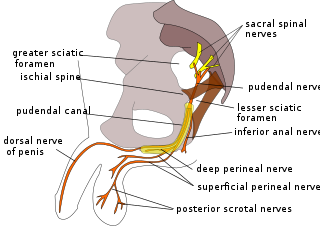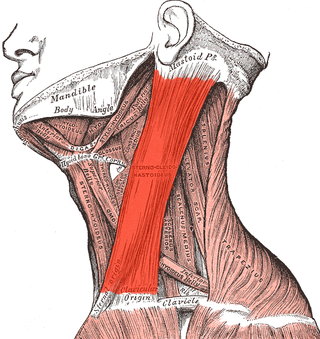Lateral is a geometric term of location which may also refer to:
Lateral is a geometric term of location which may also refer to:
Diaeresis may refer to:

In articulatory phonetics, the manner of articulation is the configuration and interaction of the articulators when making a speech sound. One parameter of manner is stricture, that is, how closely the speech organs approach one another. Others include those involved in the r-like sounds, and the sibilancy of fricatives.

In articulatory phonetics, the place of articulation of a consonant is an approximate location along the vocal tract where its production occurs. It is a point where a constriction is made between an active and a passive articulator. Active articulators are organs capable of voluntary movement which create the constriction, while passive articulators are so called because they are normally fixed and are the parts with which an active articulator makes contact. Along with the manner of articulation and phonation, the place of articulation gives the consonant its distinctive sound.

The leg is the entire lower limb of the human body, including the foot, thigh or sometimes even the hip or buttock region. The major bones of the leg are the femur, tibia, and adjacent fibula. There are 60 leg bones in each leg.

The pudendal nerve is the main nerve of the perineum. It is a mixed nerve and also conveys sympathetic autonomic fibers. It carries sensation from the external genitalia of both sexes and the skin around the anus and perineum, as well as the motor supply to various pelvic muscles, including the male or female external urethral sphincter and the external anal sphincter.
Dorsal may refer to:

The sacrum, in human anatomy, is a large, triangular bone at the base of the spine that forms by the fusing of the sacral vertebrae (S1–S5) between ages 18 and 30.

The sternocleidomastoid muscle is one of the largest and most superficial cervical muscles. The primary actions of the muscle are rotation of the head to the opposite side and flexion of the neck. The sternocleidomastoid is innervated by the accessory nerve.
The voiced alveolar lateral approximant is a type of consonantal sound used in many spoken languages. The symbol in the International Phonetic Alphabet that represents dental, alveolar, and postalveolar lateral approximants is ⟨l⟩, and the equivalent X-SAMPA symbol is l.

The voiced alveolar lateral flap is a type of consonantal sound, used in some spoken languages. The symbol in the International Phonetic Alphabet that represents this sound is ⟨ɺ⟩, a fusion of a rotated lowercase letter ⟨r⟩ with a letter ⟨l⟩. Approved in 1928, the symbol represented a sound intermediate between and or between and until 1979 when its value was redefined as an alveolar lateral flap.

The voiced alveolar lateral fricative is a type of consonantal sound, used in some spoken languages. The symbol in the International Phonetic Alphabet that represents voiced dental, alveolar, and postalveolar lateral fricatives is ⟨ɮ⟩, and the equivalent X-SAMPA symbol is K\.
The voiced alveolar fricatives are consonantal sounds. The symbol in the International Phonetic Alphabet that represents these sounds depends on whether a sibilant or non-sibilant fricative is being described.

The voiceless alveolar lateral affricate is a type of consonantal sound, used in some spoken languages. The symbol in the International Phonetic Alphabet is ⟨t͡ɬ⟩, and in Americanist phonetic notation it is ⟨ƛ⟩.
The voiced palatal lateral flap is a rare type of consonantal sound, used in some spoken languages. There is no dedicated symbol in the International Phonetic Alphabet that represents this sound. However, the symbol for a palatal lateral approximant with a breve denoting extra-short ⟨ʎ̆⟩ may be used.

The maxillary artery supplies deep structures of the face. It branches from the external carotid artery just deep to the neck of the mandible.
The voiced alveolar lateral affricate is a type of consonantal sound, used in some spoken languages. The symbol in the International Phonetic Alphabet is ⟨d͡ɮ⟩, and in Americanist phonetic notation it is ⟨λ⟩ (lambda). It is usually in free variation or an allophone of /ɮ/, /t͡ɬ/ or /l/; no known language contrasts [dɮ] and [ɮ].
A lateral flap is a family of consonantal sounds, used in some spoken languages.

The pharynx is the part of the throat behind the mouth and nasal cavity, and above the esophagus and trachea. It is found in vertebrates and invertebrates, though its structure varies across species. The pharynx carries food to the esophagus and air to the larynx. The flap of cartilage called the epiglottis stops food from entering the larynx.
The voiceless alveolar lateral flap is a type of consonantal sound, used in some spoken languages. The symbol in the International Phonetic Alphabet that represents this sound is ⟨ɺ̥⟩, a fusion of a rotated lowercase letter ⟨r⟩ with a letter ⟨l⟩ and a voiceless diacritic.
The voiceless retroflex lateral flap is a type of consonantal sound, used in some spoken languages. The implicit symbol for this sound in the International Phonetic Alphabet is ⟨𝼈̊⟩.